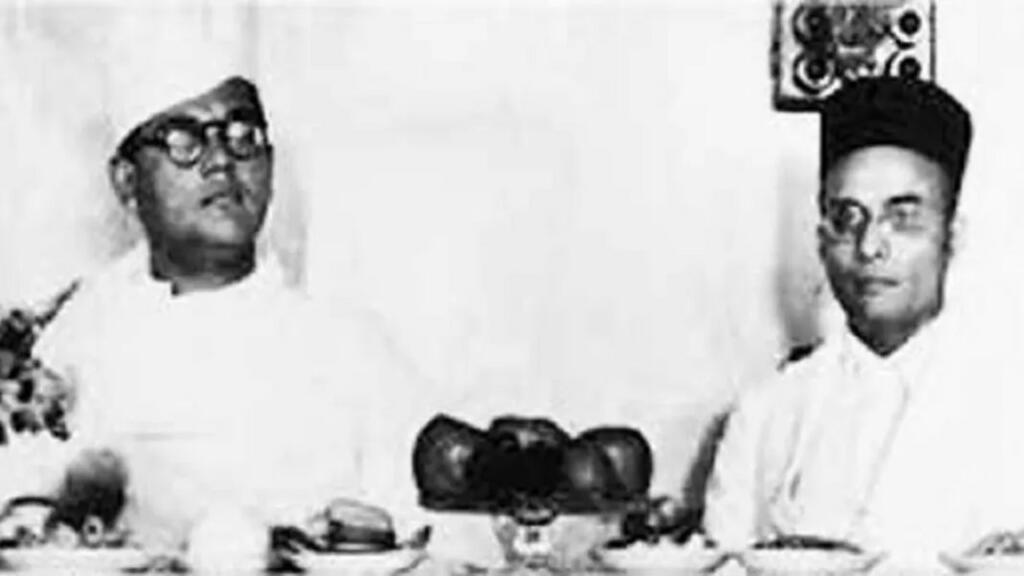The Netaji Savarkar Meeting: Unlike the version of history we have been told, Indians didn’t wage splinter and fragmented regional movements for independence, but rather these freedom movements had a definite continuum. Since the formation of Congress in 1885, the political struggle has been extensively covered. It was regarded as the sole cause of India’s independence; however, there were other contributing factors and complexities to the historical event.
In fact, even the non-violent freedom struggles were correlated. They didn’t seize even for a moment until they forced Britishers to kneel in the face of a rising tide of Indian revolutionaries. Consequently, Britishers decided to flee India before they were booted out of the nation.
These facets of the Indian freedom struggle were willfully hidden from the general masses. However, with historians like Sanjeev Sanyal and Vikram Sampath, these important events have started to regain attention.
Netaji Subhas and Veer Savarkar’s meeting: A catalyst for India’s Freedom
It is clear as day that post-Independence, the history of the Indian freedom struggle was adulterated by Marxist distorians to eulogise a few individuals and a party. To carry on their facade, they pit one revolutionary against another, touting their political differences as an ostracization of the other person’s ideology or vision to attain independence.
A frequently used argument by pseudo-intellectuals and Congress supporters is that Netaji Subhas Chandra Bose strongly disagreed with Savarkar’s ideas and the two of them rarely agreed on anything. Although having vastly differing opinions, both Netaji Subhas Chandra Bose and Savarkar shared several similarities and ultimately came together to strive for India’s independence.
For example: they held divergent views to Mahatma Gandhi and the Congress led by Jawaharlal Nehru. Both chose to pursue a strategy of militarisation and direct confrontation with the British to end colonial rule. One of the pivotal moments in their relationship was a three-hour meeting between Netaji Bose and Veer Savarkar. On June 22, 1940, it was held at Savarkar’s residence in Mumbai.
Also read: The story of shubhrak the horse who avenged his master
On June 2, 1954, Savarkar’s personal secretary, Balarao Savarkar, wrote a letter in which he revealed the discussions of the meeting.
He wrote, “It may be mentioned here that it was a private and personal meeting between Netaji Subhas Babu and Savarkarji at Savarkar Sadan Bombay that a definite suggestion was made to Subhas babu by Savarkar Ji that he should try to leave India and undertake the risk of going over to Germany to organise the Indian forces there fallen in German hands as captives and then with German help should proceed to Japan to join hands with Sri Rash Behari Bose. To impress this point, Savarkarji showed to Subhas Babu a letter from Sri Bose (Rash Behari) to Savarkarji written just on the eve of Japanese declaration of war.”
Also read: The Birbal who never existed
The to-and-fro support and praise for each other
Six months later, suggestions of Savarkar were implemented. Netaji Bose followed the exact path discussed in the meeting. In January 1941, Bose escaped from his home on Elgin Road in Kolkata to join Rash Behari Bose in Japan.
Historian Vikram Sampath, in his book Savarkar: A Contested Legacy, highlighted that in June 1942, an Indian Independence League (IIL) was established, and its conference invited Subhas Bose to East Asia.
Hailing Netaji’s great escape, Savarkar wrote, “May the gratitude, sympathy and good wishes of a nation be a source of never-failing solace and inspiration to him. Wherever he happens to be, I have no doubt he will contribute his all, even health and life to the cause of Indian freedom.”
Later, when the British took nearly 250,000 INA soldiers as prisoners, Congress maintained a deafening silence. At that time, Savarkar came out strongly in support of these INA soldiers and sent a cable to the then British Prime Minister, Clement Attlee, on December 1, 1945.
Also read: In actuality, Murli Manohar Joshi was the first education minister of India
Later, Netaji reciprocated by praising Savarkar’s efforts to motivate youth to enlist in the Armed Forces. On June 25, 1944, through a radio broadcast from Singapore, Subhas Bose talked about Savarkar.
He said, “When due to misguided political whims and lack of vision almost all the leaders of the Congress Party are decrying all the soldiers in the Indian Army as mercenaries, it is heartening to know that Veer Savarkar is fearlessly exhorting the youth of India to enlist in the Armed Forces. These enlisted youth themselves provide us with the trained men from which we draw the soldiers of our Indian National Army.”
Similarly, an eminent Congressman NB Khare in his autobiography highlighted that Subhas Chandra Bose admitted that he took his inspiration from Savarkar’s book on Indian War of Independence of 1857.
This meeting between two stalwarts (Netaji and Savarkar) changed the course of the freedom struggle, and there are many more such hidden realities and events that played a significant role in booting out the Britishers. Despite their strong political differences, all the revolutionaries had great admiration for each other. They motivated, guided, and supported each other to the maximum extent possible, and in their own ways, they enhanced the freedom struggle.
But the Marxist distorians will keep denying these unquestionable continuity of such events. Do share your insights on what could be the motive and hidden agendas behind the continuous denial by the leftist intellectuals and academicians?
Support TFI:
Support us to strengthen the ‘Right’ ideology of cultural nationalism by purchasing the best quality garments from TFI-STORE.COM
